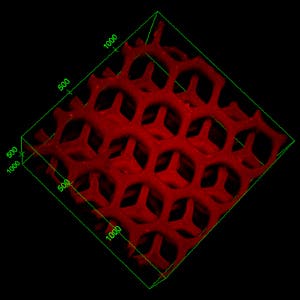Inspired by the healing properties of the human liver, researchers at University of California, San Diego created a 3D-printed biodevice which mimics the liver and removes dangerous toxins from the blood.
Used outside the body, like a dialysis machine, the device employs nanoparticles to trap pore-forming toxins that can damage cellular membranes. These toxins often result from animal bites and stings, and bacterial infections, and can cause serious illnesses.
Previous research showed that indeed nanoparticles are great for neutralizing pore-forming toxins in the blood, however at the same time these nanoparticles can not be designed in such manner that they may be effectively digested. Consequently, the capsules can act like a second poison – a time bomb – especially among patients already at risk of liver failure.
Professor Shaochen Chen solved this problem by making a 3D-printed hydrogel matrix to house nanoparticles, forming a device that mimics the function of the liver by sensing, attracting and capturing toxins routed from the blood. Chen and colleagues used a novel technique developed in-house alled dynamic optical projection stereolithography (DOPsL), which can produce the micro- and nanoscale resolution required to print tissues that mimic nature’s fine-grained details, including blood vessels, which are essential for distributing nutrients and oxygen throughout the body.

Bio-inspired 3D detoxification device: polydiacetylene (PDA)PDA nanoparticles (green) are installed in poly(ethylene glycol) diacrylate (PEGDA) hydrogel matrix (gray) with liver-mimetic 3D structure fabricated by 3D printing. The nanoparticles attract, capture and sense toxins (red), while the 3D matrix with modified liver lobule structure allows toxins to be trapped efficiently. This biomimetic 3D detoxifier has promising clinical application for detoxification by collecting and removing toxins. (Credit: Maling Gou et al., Nature Communications)
The device, mimics the structure of the liver, with all its intricate details, only it has a large surface area. This allows the device to attract and trap more toxins. Experiments in the lab so far proved the device can completely neutralize pore-forming toxins.
“One unique feature of this device is that it turns red when the toxins are captured,” said the co-first author, Xin Qu, who is a postdoctoral researcher working in Chen’s laboratory. “The concept of using 3D printing to encapsulate functional nanoparticles in a biocompatible hydrogel is novel,” said Chen. “This will inspire many new designs for detoxification techniques since 3D printing allows user-specific or site-specific manufacturing of highly functional products,” Chen said.
The findings were published May 8 in the journal Nature Communications.










